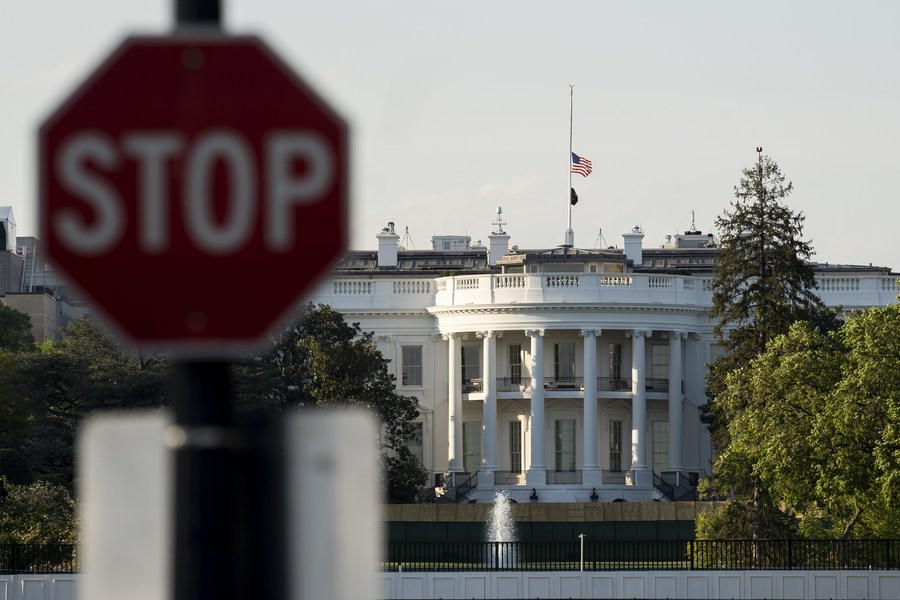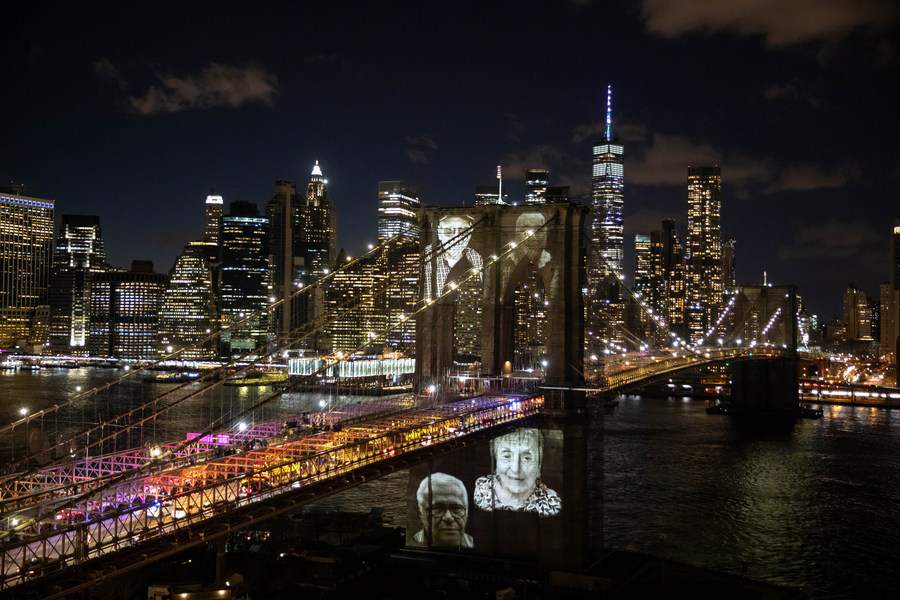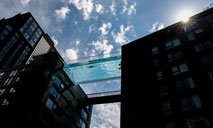How does America intensify disinformation war?
-- Passing through the U.S. government and mainstream media, there is a covert but efficient production line, along which raw materials of misinformation are processed into eye-popping headlines, and peddled to the public.
-- Gordon's WSJ story on the COVID-19 origin is repeating the classic U.S. tactics deployed in its previous disinformation campaigns, like those against Iraq and Iran, in which the U.S. government leaked some deceptive information and the media acted as an amplifier.
-- From smearing China's policies in Xinjiang, Tibet, Hong Kong and Taiwan to stigmatizing China's efforts for equitable vaccine sharing and a prosperous Belt and Road, Washington has ganged up with media outlets in waging a comprehensive disinformation war against China.
BEIJING, June 8 (Xinhua) -- Passing through the U.S. government and mainstream media, there is a covert but efficient production line, along which raw materials of misinformation are processed into eye-popping headlines, and peddled to the public.
Now, the production line is rumbling again. On May 23, the Wall Street Journal (WSJ) published a story that cited a so-called "previously undisclosed U.S. intelligence report" to rekindle the already-debunked Wuhan lab leak conspiracy concerning COVID-19's origin. Three days later, U.S. President Joe Biden joined forces by asking the U.S. intelligence to draw "a definitive conclusion" on the virus' origin.
Such concerted steps taken by the U.S. government and media exemplify a notorious disinformation ploy frequently manipulated by the world's sole superpower to mislead the public or demonize its opponents, which, experts have warned, is poisonous to U.S. relations with other countries and the world.
A DISCREDITED REPORTER
The first writer of the WSJ story is Michael R. Gordon, a skillful worker on the U.S. production line of misinformation.
Working as a correspondent for The New York Times (NYT) before joining the WSJ in late 2017, Gordon's credibility as a reporter was drained for inaccurate coverage and relying on anonymous sources in multiple key reports.

Photo taken on April 20, 2021 shows the White House in Washington, D.C., the United States. (Xinhua/Liu Jie)
On Sept. 8, 2002, Gordon and Judith Miller published a report titled "U.S. Says Hussein Intensifies Quest for A-Bomb Parts," which played a key role in raising public support for the unjustified war on Iraq. The only sources for his story were either "anonymous American officials" or "Intelligence experts."
Gordon, on his own, or with Miller, wrote some of the key and misleading articles about the fabricated Iraqi possession of weapons of mass destruction in the run-up to the 2003 invasion, including the infamous "aluminum tubes" story.
His allegations against Iraq were proved baseless after the invasion led to horrible civilian casualties in the Middle East country.
In February 2007, the NYT again carried a front page story by Gordon with the title of "Deadliest Bomb in Iraq is Made by Iran, U.S. Says." He wrote that "an increasing body of evidence" suggests "an Iranian role" in supplying the "deadliest weapon aimed at American troops in Iraq." All the sources cited in the story were unnamed, and the assertion of the story was untrue.
Now, Gordon played the old trick again. Quoting "a previously undisclosed U.S. intelligence report," the discredited reporter hinted at a far-fetched connection between the "sick staff" of China's Wuhan Institute of Virology and the COVID-19 outbreak, claiming the intelligence report "could add weight to growing calls for a fuller probe of whether the COVID-19 virus may have escaped from the laboratory."
As Matthias Glaubrecht, scientific director and professor from the Department of Animal Diversity at the University of Hamburg, noted, "Secret service reports usually have the property that they are secret and will remain secret. So we cannot check whether such a report actually exists, what is really there and what evidence is included, if any."
A CLASSIC PLOY
Gordon's WSJ story on the COVID-19 origin is repeating the classic U.S. tactics deployed in its previous disinformation campaigns, like those against Iraq and Iran, in which the U.S. government leaked some deceptive information and the media acted as an amplifier.

Photo taken on March 11, 2021 shows the White House in Washington, D.C., the United States. (Xinhua/Liu Jie)
In the latest COVID-19 origin episode, Gordon obtained so-called "information" from "a previously undisclosed U.S. intelligence report," and recounted it with amplification. Other media followed up, widely citing the Gordon story to hype up the topic. A few days later, the White House called for an intelligence report on the origins of COVID-19 within 90 days.
"This is the usual trick used by the United States for its strategic needs," said Pu Ping, a professor on international relations at the Renmin University of China.
It is an obvious fact the United States has failed in its fight against COVID-19, so it is seeking to divert public attention away from its failure, Pu said, adding "no matter whether the evidence is true or not, the U.S. government is bound to do so from its own strategic considerations."

Images of New Yorkers lost to the COVID-19 pandemic are projected onto the Brooklyn Bridge in New York, the United States, March 14, 2021. (Xinhua/Michael Nagle)
Meanwhile, "in terms of the U.S. media, they mistrust and ideologically reject China, which has compelled them to consciously report this kind of news in that direction. It is not only a strategic need, but also a result of ideological prejudice and hostility (against China)," Pu said.
As U.S. reporters Amy Goodman and David Goodman pointed out in 2004, this was the "classic disinformation two-step," in which the White House first leaks a lie to a U.S. media outlet, and the latter publishes it as a startling exposure; then, the White House conveniently masquerades behind the credibility of the media.
Under this pattern, the U.S. media have descended into Washington's accomplices in disseminating misinformation for political and economic purposes.
"Network newscasts, dominated by current and former U.S. officials, largely exclude Americans who are skeptical of or opposed to an invasion of Iraq," said U.S. media criticism organization Fairness and Accuracy In Reporting (FAIR) in 2003.
Examining 393 on-camera sources who appeared in nightly news stories about Iraq on ABC, CBS, NBC and PBS, FAIR found out that 267 of the guests were from the United States, of whom, a striking 75 percent (199) were either current or former government or military officials.
Only one of the official U.S. sources expressed skepticism or opposition to the war, according to FAIR.
The U.S. media are essentially the vanguard of the U.S. national interest in the global geopolitical game, said Hui Ching, research director at the Hong Kong Zhi Ming Institute.
"After World War II, the geopolitical conflicts provoked by the United States were basically driven by economic interests, through diplomatic and military means, among which the media war was the first to be launched," Hui added.
Michael Lueders, a well-known German writer, reveals the relationship between Western media, governments and capital in a recent book titled The Hypocritical Superpower.
Many Western media reports are somehow filtered by interest groups in the United States, Lueders noted in the book.
A DOOMED WAR
Actually, the Wuhan lab leak conspiracy is only one piece of the great variety of products that have been manufactured on the U.S. disinformation production line, which is busy cutting out facts and fabricating lies to demonize China.
From smearing China's policies in Xinjiang, Tibet, Hong Kong and Taiwan to stigmatizing China's efforts for equitable vaccine sharing and a prosperous Belt and Road, Washington has ganged up with media outlets in waging a comprehensive disinformation war against China.
"A clear large-scale campaign is currently being carried out against China," Pavel Feldman, deputy director of the Institute for Strategic Studies and Forecasts of the Peoples' Friendship University of Russia, was quoted by Russian newspaper Saint-Petersburg Vedomosti as saying.
"Such accusations (against China) became part of a large political game on the international arena between the main power centers -- the West believes China challenges its own civilization," Feldman said.

A donation of COVID-19 vaccine from Chinese pharmaceutical company Sinopharm arrives at the N'Djamena International Airport in Chad, June 2, 2021. (Chinese Embassy in Chad/Handout via Xinhua)
Observers have warned against the destructive results of the U.S. disinformation campaign against China.
"It's very rare that you find an objective, analytical piece that describes in detail what's going on within domestic policies in China. We always have a certain framing," Lueders, the German writer, told Xinhua.
"This, in my view, is wrong thinking. It's dangerous thinking because it leads to a confrontational policy," said the author.
Noting his target readers are mostly Germans and Europeans, Lueders said he hopes that local media and audience can abandon such framing and "step out of the shadow of the USA."
"The stigmatization of China is a poison to China-U.S. relations. In the long run, it may aggravate ... the mutual mistrust and misunderstanding between the two peoples," warned Pu, the international relations professor.
Noting "China is a big country and our culture is relatively independent," Pu said China will stick to its own established development path, no matter how the United States will play its disinformation trick.
Photos
Related Stories
- U.S. Intelligence Community refuses to accept facts: I just won't listen
- Afghan president meets with U.S. peace delegation in Kabul
- 3 dead, multiple injured in U.S. Florida graduation party shooting
- U.S. newspaper bashed for headline change to play up lab-leak theories: media
- Hurry up America, donate those vaccines!
Copyright © 2021 People's Daily Online. All Rights Reserved.










